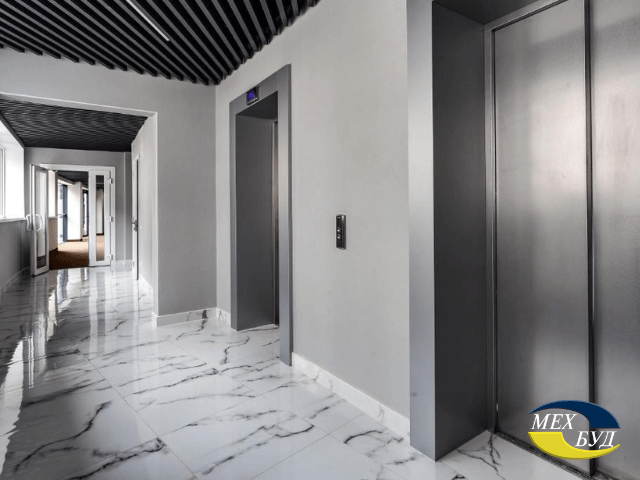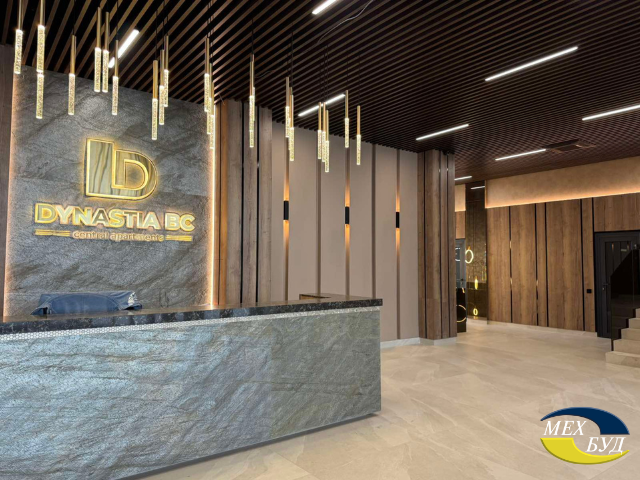Ceilings for Residential Complexes
The interior finishing of residential complexes is intended to solve a range of tasks, from concealing utilities to providing attractive aesthetics to the spaces. Ceilings are no exception here: structures installed on the ceiling slabs serve multiple functions. That’s why selecting ceilings for various residential complexes requires a high level of responsibility.
In this article, we will briefly describe the main requirements that ceiling structures must meet and provide recommendations for choosing ceilings for different types of spaces.
REGULATORY DOCUMENTS
In Ukraine, the installation of suspended metal ceilings in residential complexes is regulated by several regulatory documents, including:
- DBN V.2.2-4-2014 Residential Buildings and Structures. General Design Requirements.
- DBN V.2.2-15-2010 “Buildings and Structures for Public Use.”
- DBN V.2.2-3-2006 Buildings and Structures. Design Standards.
- DBN V.2.6-31:2016 “Building and Structure Constructions. Metal Structures. General Provisions.”
These regulatory documents establish general requirements and recommendations to consider during the design and installation of metal suspended ceilings in residential complexes. For specific cases, it is advisable to consult with professionals in design and construction to obtain detailed information and specific recommendations.
GENERAL CEILING REQUIREMENTS
Currently, the de facto standard for ceilings is the installation of suspended structures. Their frameworks are attached to the structural floor slabs, and ceiling panels, rails, cassettes, modules, and so on are fixed on the load-bearing elements, forming the ceiling surface.
The following requirements are imposed on suspended ceiling structures:
- Structural Requirements: Suspended metal ceilings must meet requirements for strength, durability, and longevity. They must be designed and manufactured with consideration for the loads acting on the structure, including the weight of the ceiling, loads from other systems (lighting, ventilation, electricity), and external influences.
- Attractive Appearance: The primary function of a ceiling in a residential complex is aesthetic. This means that the surface must be perfectly even, and individual elements must be aesthetically pleasing.
- Strength and Durability: In principle, a suspended ceiling system should not be designed for significant loads. However, a certain level of strength is necessary, as even minor impacts can lead to ceiling deformation.
- Resistance to External Influences: First and foremost, the ceiling covering must be moisture-resistant, as moisture ingress is often the cause of deformation or degradation of the ceiling finish.
- Safety: Fire protection takes priority here. In residential complexes, communication systems, including electrical wiring, are often located behind the ceiling slabs. Using non-combustible materials in ceiling construction minimizes the risk of fire.
- Acoustic Efficiency: Suspended metal ceilings can be used to improve the acoustic characteristics of spaces. They can possess special sound insulation and sound absorption properties, contributing to a comfortable acoustic environment in residential spaces.
All products from the “Mehbud” factory fully comply with these requirements. However, the range of ceiling structures is extensive, and there are differences between various options. To make it easier for you to choose ceilings for different spaces in residential complexes, the following section will provide a series of recommendations from our experts.
CEILING STRUCTURES FOR DIFFERENT SPACES
Organizing the interior space of residential complexes involves categorizing all spaces into several categories:
- Residential Spaces.
- Common Access Spaces.
- Auxiliary and Technical Spaces.
The choice of ceiling in residential spaces is determined by the preferences and tastes of their owners. However, for spaces in categories 2 and 3, ceiling structures are selected based on a uniform scheme.
The choice of the type of construction and the specific model is determined by the conditions in which the ceiling will be operated. Different spaces have different conditions, so the type of space will be the priority when selecting a ceiling.
CEILINGS FOR CORRIDORS
Corridors in residential complexes are some of the most intensively used areas. Corridor ceilings must meet relatively high requirements, making practical designs with simplicity, a clean design, and durability ideal.
An excellent option for corridor ceilings is a rack-type corridor ceiling:
- The main advantage of the specialized corridor system from the “Mehbud” company is the absence of the need for substructure installation. In small typical corridors, ceiling elements are simply placed on brackets attached to the walls, without the need for suspensions.
- This installation scheme not only reduces the cost of corridor ceilings (which is important as corridors in residential complexes can be significant in length), but also simplifies their maintenance. Any rail can be disassembled in a matter of seconds to access utilities at any point in the corridor.
- The main elements used are elongated rails up to 1 mm thick, made either of aluminum or steel with zinc coating. When necessary, panels can be painted with protective-decorative coatings.
As an alternative to a rack-type corridor ceiling, a panel-rack or rectangular construction can be considered:
- Both varieties are mounted on a load-bearing structure to provide rigidity and secure fixation.
- In the first case, the plane is formed from a combination of panels and rails, while in the second case, it consists of rails of varying length and width that create a unique pattern.
In any case, it is advisable to use rack (or similar) systems for ceiling finishing in corridors. This is primarily due to the configuration of such rooms.
CEILINGS FOR LOBBIES AND FOYERS
In contrast to commercial real estate, lobbies and foyers of residential complexes do not typically have high operational loads. Nevertheless, ceilings in these areas should be durable, reliable, and aesthetically pleasing. It’s also essential to consider the technical aspect: often, lobbies are designed with considerable height, so it’s advisable to choose ceiling structures that can be fixed at a certain distance from the floor slab.
An excellent choice for the foyer or lobby of a residential complex would be either a cassette or panel ceiling:
- Ceilings of this type are mounted on a substructure made of metal guides.
- The substructure is fixed to the ceiling slab either using brackets or (if it’s necessary to lower the ceiling significantly) with the help of suspensions.
- When installing the substructure, the dimensions of the main ceiling elements, such as cassettes or panels, are taken into account.
- These elements are placed on the guides, forming the ceiling’s surface.
The appearance of the ceiling in the lobby or foyer of the residential complex is primarily determined by the type of elements used:
- Panels placed on the guides can be either flat or three-dimensional. In the first case, a flat surface is obtained, while in the second case, the lower parts of the panels protrude beyond the ceiling’s plane, creating a clearly visible relief.
- Thin-sheet metal (aluminum 0.4–0.8 mm or galvanized steel 0.45–0.7 mm) is used to manufacture panels.
- The front surface is covered with a decorative composition, the color and texture of which can be selected based on the room’s interior design. In addition to the decorative function, such compositions provide additional protection for the metal base against corrosion.
- Ceiling panels are most often produced in standard dimensions of 600×600 mm. This facilitates the installation of the substructure and simplifies the selection of luminaires. In foyers and lobbies, standard lamps suitable for ceiling systems like “Armstrong” can be installed.
The main difference between ceiling cassettes and the panels described above is the greater thickness of the metal (up to 2 mm). On one hand, the use of thick cassettes increases the load on the ceiling slab, and the suspension system must be more robust. On the other hand, cassette ceilings are characterized by greater durability: due to the use of a thick metal base, their individual elements are less prone to deformation.
Additionally, cassette ceilings offer more possibilities for decorating the lobby or foyer. This is because, unlike ceiling panels, cassettes can have different sizes. This significantly expands the design potential of such ceilings.
CEILINGS FOR ELEVATORS
In economy-class residential buildings, elevators are typically used without additional ceiling structures. However, in residential complexes, custom interior finishes for elevators are quite common, and these finishes often include ceiling constructions.

Ceiling constructions in elevators serve two main purposes:
- Enhance the elevator’s overall appearance.
- Protect communications and technical access points on the ceiling from unauthorized access.
For the decoration of elevator ceilings in residential complexes, cassette or rack ceilings are commonly used:
- Metal cassettes are an excellent choice for spacious elevators. Ceiling finishing with cassettes provides a reliable and durable solution. Another advantage of ceiling cassettes is their high vandal resistance.
- An alternative to metal ceiling cassettes is the use of rack ceilings. Rack ceilings are a good option for elevators with limited space. Rack constructions offer both practicality and good design qualities.
When decorating elevators, it’s important not to overlook effective lighting. If cassette ceiling constructions are used, panel lights are usually integrated into them. For rack constructions, using multiple recessed spotlights is an optimal solution.
CEILINGS FOR BASEMENTS, STORAGE ROOMS, AND OTHER TECHNICAL SPACES
When designing a residential complex, it’s important to pay attention not only to common areas but also to technical spaces. Installing a modern suspended ceiling in these areas can improve the microclimate and aesthetics.
Technical spaces such as warehouses, basements, and storage rooms often face the challenge of high humidity. This makes alternatives to metal suspended ceilings almost non-existent:
- Plaster used for leveling floors in these areas eventually becomes damp.
- Panels made of drywall or mineral fiber also exhibit high moisture absorbency.
The solution lies in installing a metal ceiling structure. The choice of the specific type depends on the importance of decorative potential. For a straightforward solution, cassette or rack ceilings can be selected. Cassettes and rack components with anti-corrosion coatings withstand well in humid environments and can maintain their appearance for over 10 years.
However, if there’s a need for an aesthetically pleasing ceiling in a high humidity environment (e.g., for a pool area or a gym located in the basement), a cube-shaped structure can be considered. Metal Cubic shaped ceiling components have high corrosion resistance and offer an attractive appearance.
CEILING DESIGN TRENDS FOR 2025 IN RESIDENTIAL COMPLEXES
In 2025, the design of ceiling spaces in residential complexes will emphasize the use of cubic shaped and rectangular ceilings, which provide a modern and elegant look. Ceilings of this type offer several advantages, such as durability, reliability, and ease of installation.
The texture of wood will also be popular, creating a cozy and natural atmosphere in interiors. Metal ceilings are capable of mimicking various textures, such as wood or stone, making them versatile and favored by designers.
Furthermore, illuminated ceilings will be a trend, helping to create a unique lighting effect and adding an extra focal point to the space.
Overall, in 2025, the design of ceiling spaces in residential complexes will focus on combining minimalism, functionality, and beauty.
Completed Projects by Mehbud
Aston Hall Residential Complex, Odessa
Cube-shaped ceiling panels made of galvanized steel in a “wood” finish create a stylish and modern look.
LED fixtures provide perfect lighting, highlighting the design, while the panels visually expand the space, adding sophistication.
Benefits: durability, fire resistance, moisture resistance. Ideal for pools, cafes, shops, and large public spaces.

Dynasty Residential Complex, Bila Tserkva
Cube-shaped metal ceiling in “golden oak” serves as a striking architectural accent.
The modular system allows quick installation, strength, and visual depth, enhancing corridors and public areas.
Benefits: precision, reliability, versatility — perfect for residential entrances, shopping centers, and business spaces.

White Lines Residential Complex, Kyiv
Rectangular ceiling adds modernity and emphasizes the uniqueness of the complex.
LED lights are integrated between the panels, providing even lighting and highlighting architectural features.
Benefits: design flexibility, easy installation, integrated lighting for a distinctive atmosphere.

CONCLUSION
The extensive range of metal products offered by “Mehbud” company for ceiling installations in residential complexes allows for choosing the optimal solution for virtually any space. Whether it’s rack, cassette, panel, or other constructions, they all share qualities like durability, resistance to external factors, and ease of installation. Moreover, suspended ceilings made from high-quality materials complement modern interiors beautifully.
